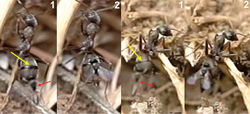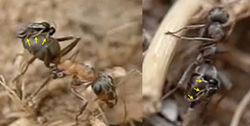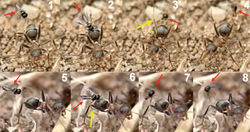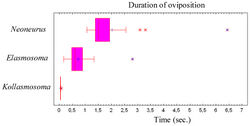Elasmosoma luxemburgense
| Notice: | This page is derived from the original publication listed below, whose author(s) should always be credited. Further contributors may edit and improve the content of this page and, consequently, need to be credited as well (see page history). Any assessment of factual correctness requires a careful review of the original article as well as of subsequent contributions.
If you are uncertain whether your planned contribution is correct or not, we suggest that you use the associated discussion page instead of editing the page directly. This page should be cited as follows (rationale):
Citation formats to copy and paste
BibTeX: @article{Gómez2011ZooKeys125, RIS/ Endnote: TY - JOUR Wikipedia/ Citizendium: <ref name="Gómez2011ZooKeys125">{{Citation See also the citation download page at the journal. |
Ordo: Hymenoptera
Familia: Braconidae
Genus: Elasmosoma
Name
Elasmosoma luxemburgense Wasmann, 1909 – Wikispecies link – Pensoft Profile
Oviposition behaviour
Oviposition of Elasmosoma spp. into the ants’ metasoma has long been observed (Forel 1874[1]; Olivier 1893[2]; Pierre 1893[3]; Wasmann 1897[4]; Donisthorpe 1927[5]; Kariya 1932[6]), and adults of Elasmosoma have been reared from Formica nests on various occasions (Wasmann 1897[4]; Watanabe 1935[7]; Poinar 2004[8]). Due to the very quick act of oviposition, few details are known about the accompanying behaviour of grasping the ant or about the location of ovipositor insertion. Wasmann (1897)[4] supposed that Elasmosoma females lay the eggs between the abdominal segments; other authors, considering the strongly curved morphology of the ovipositor, have suggested that the eggs are probably laid through the anus (Huddleston 1976[9]; van Achterberg and Argaman 1993[10]). Here we report new observations on the oviposition behaviour of Elasmosoma luxemburgense on Formica rufibarbis Fabricius, 1793, comprising alighting and grasping the worker ant and ovipositor insertion.
The observations were made in Almazán (Soria, Spain) in August, 2010 on a warm and calm day between 12.26 PM and 13.38 PM. A group of 30 to 40 of Formica rufibarbis workers were present surrounding a nest entrance on the ground. They were excited and aggressive, carrying materials, entering and leaving the nest. Some cadavers of another species of ant and isolated fights indicated that a more extensive battle recently occurred. Forel (1874)[1] noted that these struggle situations attract Elasmosoma berolinense, and possibly the formic acid exuded in the course of these fights serve as a kairomon to the parasitoid wasps (Huddleston, 1976). During the 72 minutes of observation, groups of 2–3 females of Elasmosoma luxemburgense could be seen hovering over and attacking the ants at a height of 1–3 cm from the ground. A total of 50 attempts at oviposition was recorded (Movie Elasmosoma, Appendix I). The ants were aware of these attacks, turning around and chasing the wasps with open mandibles. On one occasion, a worker caught a wasp while flying (Movie Elasmosoma, last sequence).
The wasp attacks always come from behind, paralleling their longitudinal axis to those of the ants. When they are less than 1 cm from an ant they dart forward and the fore legs contact the dorsal surface of the metasoma first. Meanwhile the hind legs, arranged in curved shape, are situated to brace the apex of the metasoma (Fig. 2).
Contact with the fore legs is usually followed by hitting of the parasitoid’s head on the host’s metasoma. At this moment the middle and hind legs grasp the metasoma and the wasp folds its wings. The site chosen by the wasp for the initial hit of the fore legs, or the head, is usually the posterior margin of the first gastral segment (T1; Fig. 3), i.e., of a total of 48 hits observed, 44 were on the posterior margin of the first gastral segment (91.7%), three on the posterior margin of the second (6.3%), and one on the posterior margin of the third (2%).
When the hit occurs at the posterior margin of the second or third gastral segments, the wasp climbs onto the metasoma, changing its position to reach the posterior margin of the first gastral segment (Fig. 4).
This locational preference for alighting may be visually stimulated by the differentiated border of the posterior margin of the first gastral segment, enhanced by the characteristic dark stripe behind it. The frame analysis in the film clip suggests that the wasp’s head hits the posterior margin of T1 with the mandibles opened, and that a slight deformation of the suture between T1 and T2 is produced. Presumably, the modified structure of the T1-T2 suture is used by the wasp to secure its grasp. The tarsal modifications of Elasmosoma (vestigial tarsal claws and enlarged pulvillus; Shaw 1985[11], 2007[12]) may be adaptations to effect this grasping behaviour. In the final arrangement, prior to oviposition, the fore tarsi usually grasp the posterior margin of the first gastral segment, and the hind tibiae and tarsi brace the apex of the metasoma on the fourth gastral segment, with the middle legs positioned near or somewhat posterior to the hind margin of the second gastral segment (Fig. 5).
This arrangement of the legs facilitates the appropriate position of the wasp’s metasoma in order to insert the ovipositor into the posterior area of the last metasomal segment, between the pygidium and the hypopygium, probably through the anus. Poinar (2004)[8] dissected the metasoma of the ant Formica obscuriventris clivia Creighton, 1940, a host of Elasmosoma michaeli Shaw, 2007, and found for the first time the wasp egg “just under the body wall of the ant’s metasoma.”
The precise moment of ovipositor insertion could be detected by the conspicuous downward-movement of the apex of the wasp’s metasoma (Fig. 6 and first sequence of Movie Elasmosoma). Although one single movement of the apex of the metasoma normally occurred during oviposition, in some cases 2 or 3 consecutive movements were observed. On one occasion the same wasp alighted and oviposited two consecutive times in the same ant.
Oviposition attempts sometimes failed due to strong movements of the ant’s metasoma, to strikes by the ant’s legs, or because of defective alighting by the wasp (Fig. 7). Of a total of 50 oviposition attempts, 40 were successful (80%) and 10 failed (20%). The whole oviposition behaviour of Elasmosoma luxemburgense (comprising grasping of the ant by the wasp and the insertion of the ovipositor, until taking off) lasted a mean of 0.727 seconds (95% confidence interval: 0.578–0.877; N = 38; SE = 0.074), with a median of 0.602 seconds (interquartile range: 0.480–0.900) (Fig. 79).
Taxon Treatment
- Gómez Durán, J; van Achterberg, C; 2011: Oviposition behaviour of four ant parasitoids (Hymenoptera, Braconidae, Euphorinae, Neoneurini and Ichneumonidae, Hybrizontinae), with the description of three new European species ZooKeys, 125: 59-106. doi
Other References
- ↑ 1.0 1.1 Forel A (1874) Les fourmis de la Suisse. Systématique. Notices anatomiques et physiologiques. Architecture. Distribution géographique. Nouvelles expériences et observations de moeurs. Neue Denkschriften der Allgemeinen Schweizerischen Gesellschaft für die gesammten Naturwissenschaften 26: 1-452.
- ↑ Olivier E (1893) [No title]. Annales de la Société Entomologique de France 1893: 71.
- ↑ Pierre A (1893) Un parasite des fourmis Elasmosoma berolinense Ruthe. Revue Scientifique du Bourbonnais et du Centre de la France 6: 112-114.
- ↑ 4.0 4.1 4.2 Wasmann E (1897) [Note]. In: Marshall T (Ed) Species des Hyménoptères d’Europe et d’Algérie 5: 188-189.
- ↑ Donisthorpe H (1927) The Guests of British Ants. London, 244.
- ↑ Kariya M (1932) [Observations on a braconid species parasitic on ants]. Konchu Sekai 36: 298–301. [in Japanese]
- ↑ Watanabe C (1935) On two hymenopterous guests of ants in Japan. Insecta Matsumurana 9: 90-94.
- ↑ 8.0 8.1 Poinar G (2004) Behaviour and development of Elasmosoma sp. (Braconidae: Hymenoptera), an endoparasitoid of Formica ants (Formicidae: Hymenoptera). Parasitology 128: 1-11. doi: 10.1017/S0031182004004809
- ↑ Huddleston T (1976) A revision of Elasmosoma Ruthe (Hymenoptera, Braconidae) with two new species from Mongolia. Annales Historico-Naturales Musei Nationalis Hungarici 68: 215-225.
- ↑ van Achterberg C, Argaman Q (1993) Kollasmosoma gen. nov. and a key to the genera of the subfamily Neoneurinae (Hymenoptera: Braconidae). Zoologische Mededelingen Leiden 67: 63-74.
- ↑ Shaw S (1985) A phylogenetic study of the subfamilies Meteorinae and Euphorinae (Hymenoptera: Braconidae). Entomography 3: 277-370.
- ↑ Shaw S (2007) A new species of Elasmosoma Ruthe (Hymenoptera: Braconidae: Neoneurinae) from the northwestern United States associated with the western thatching ants, Formica obscuripes Forel and Formica obscuriventris clivia Creighton (Hymenoptera: Formicidae). Proceedings of the Entomological Society of Washington 109: 1-8.
Images
|







